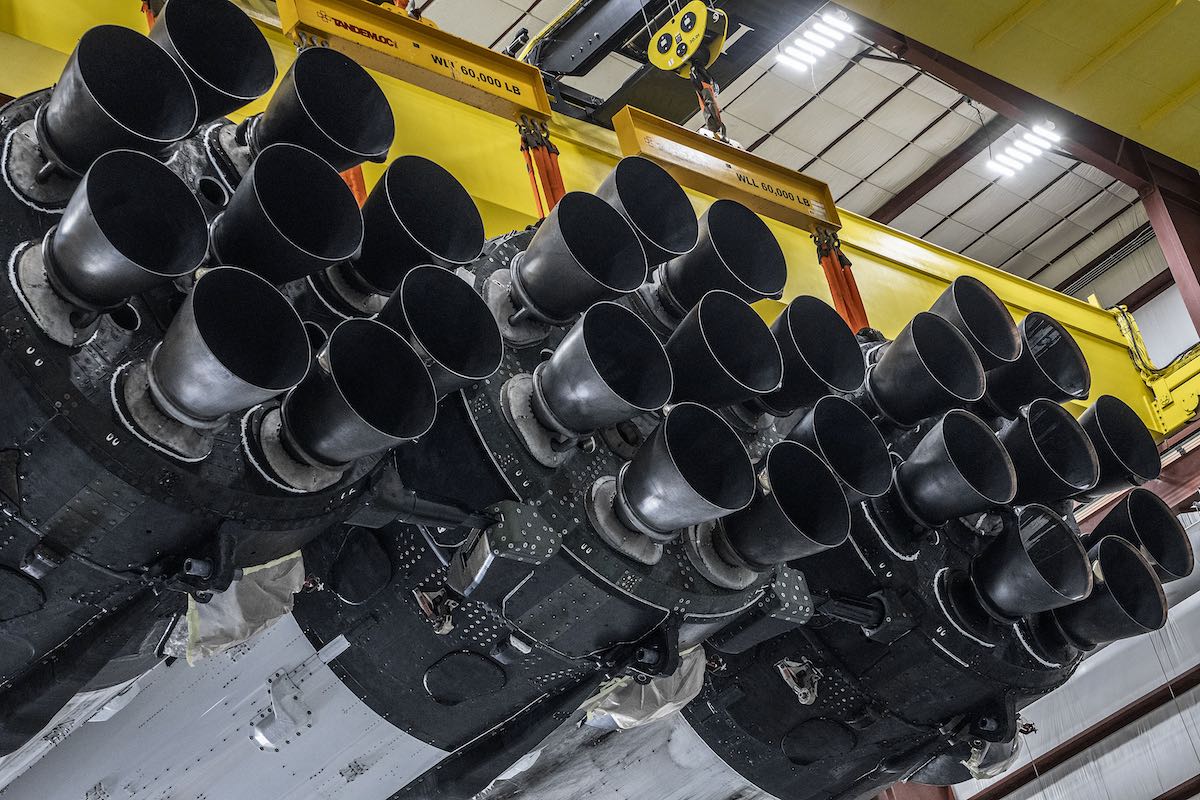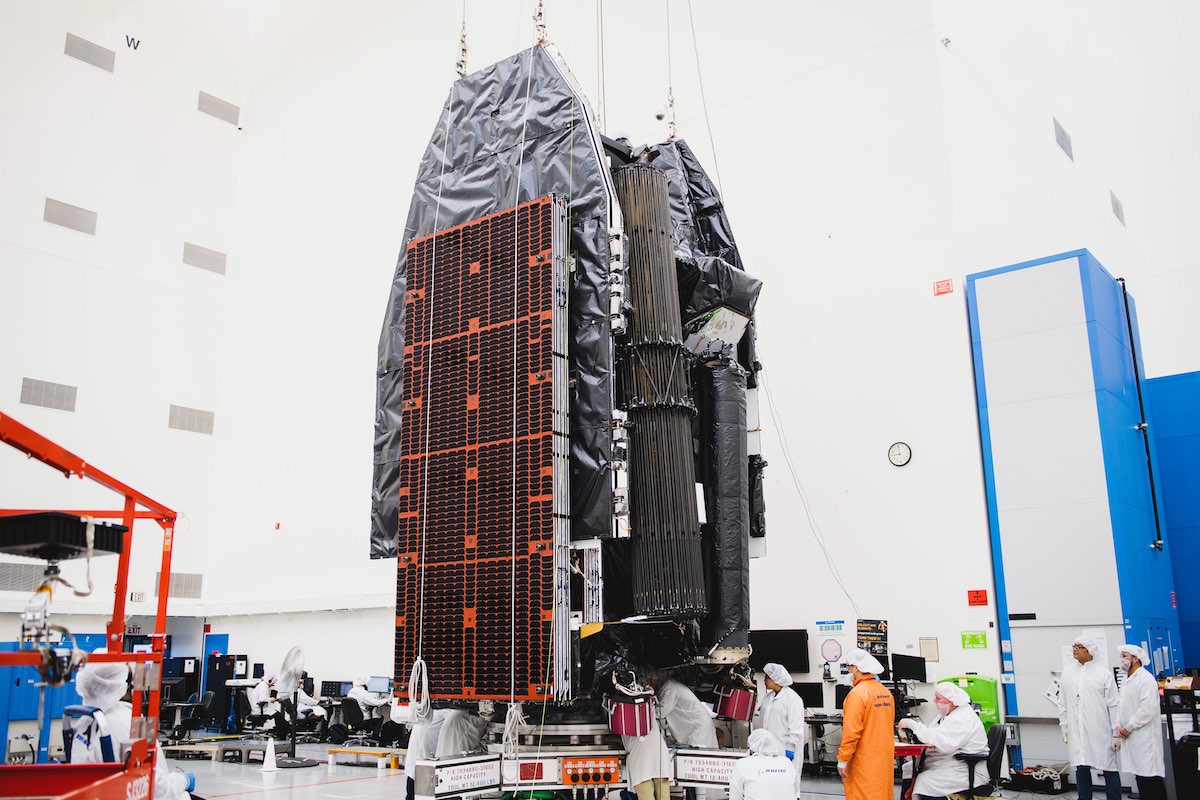
SpaceX’s next Falcon Heavy mission, set for April 18 from NASA’s Kennedy Space Center in Florida, will launch a powerhouse bus-sized broadband satellite for Viasat into a high-altitude circular geostationary orbit, a demanding flight profile that will require disposal of all three of the rocket’s reusable boosters.
The company’s sixth Falcon Heavy launch will send Viasat’s new broadband satellite into geostationary orbit on a roughly six-hour mission including multiple firings by the rocket’s upper stage. The maneuvers will place Viasat’s new six-ton internet satellite and a small rideshare communications satellite for the startup company Astranis into a circular orbit roughly 22,000 miles (35,000 kilometers) over the equator.
SpaceX technicians have assembled the three Falcon Heavy booster stages together inside a hangar just south of Launch Complex 39A. Ground crews rolled the rocket the quarter-mile distance to the launch pad Wednesday in preparation for a test-firing of its 27 Merlin main engines as soon as Thursday. The test-firing will last nearly 10 seconds, with the 27 engines briefly throttling up to generate some 5 million pounds of thrust.
The hold-down firing will occur without the Falcon Heavy’s payload, which is completing pre-launch preparations at a separate SpaceX payload processing facility. After the test-firing, SpaceX will move the payload fairing containing the ViaSat 3 Americas broadband satellite and Astranis’s Arcturus communications spacecraft over to the hangar.
After the Falcon Heavy completes the test-firing, SpaceX will lower the rocket horizontal and roll it back to the hangar for integration with the payload compartment. Early next week, teams will return the fully-integrated launch vehicle to pad 39A and raise it vertical for the final countdown.
The launch window opens at 7:36 p.m. EDT (2336 UTC) next Tuesday, April 18, or shortly before sunset at the Florida spaceport.
The Falcon Heavy rocket’s two side boosters will fire at full power for two-and-a-half minutes, then jettison to fall into the Atlantic Ocean a few hundred miles east of Cape Canaveral. The core stage will then throttle up to full power and burn for about a minute-and-a-half longer, then separate for its own destructive plunge into the sea.
The center core for the next Falcon Heavy launch is brand new, while the two side boosters are refurbished rockets flown on two Falcon Heavy missions in 2019. The weight of the ViaSat 3 Americas satellite, coupled with the high-altitude target orbit, will not leave enough leftover propellant in the boosters for landing maneuvers.
The upper stage will ignite its single engine for the first of three planned burns, first to place the ViaSat 3 Americas and Arcturus satellites into a parking orbit, then to raise the apogee, or high point, of the orbit to an altitude of more than 20,000 miles. After coasting through space nearly six hours, the upper stage will reignite its engine a final time to circularize the orbit over the equator.
Then the ViaSat 3 Americas and Arcturus satellites will deploy from the Falcon Heavy rocket to wrap up the multi-hour launch sequence.
The launch will be SpaceX’s third Falcon Heavy flights to place payloads directly into an orbit close to geostationary altitude, one of the most challenging mission types in the launch industry. The profile requires extended battery life on the upper stage, plus a custom band of gray thermal paint on the rocket to help ensure the kerosene fuel does not freeze during the hours spent in the cold environment of space.
The previous SpaceX missions with direct insertions into geostationary orbit carried satellites for the U.S. Space Force. Some details about those missions in November and January were classified, but the satellites were presumably lighter in weight than the payloads on the Falcon Heavy launch next week. SpaceX was able to recover the Falcon Heavy’s side boosters on the two recent Space Force launches.

ViaSat 3 Americas is the first of three new-generation broadband satellites for Viasat, which beams internet signals for underserved consumers, businesses, and governments. Based in Carlsbad, California, Viasat has agreements to provide in-flight WiFi to passengers on Delta Air Lines, American Airlines, United Airlines, Southwest Airlines, JetBlue, and other commercial airlines.
The Boeing-built spacecraft weighs about 6 metric tons (about 13,000 pounds), according to Viasat. The satellite is as big as a school bus, and its solar panels will unfurl in orbit to generate more than 30 kilowatts of power in orbit, more than a quarter the electrical power produced by all the solar arrays on the International Space Station.
“We designed, built and delivered the most powerful satellite platform we have ever provided to a customer. The result really is an engineering marvel,” said Michelle Parker, vice president of space mission systems at Boeing Defense, Space & Security. “We expanded the boundaries of our design and the platform components to exceed Viasat’s demanding mission requirements, while ensuring alignment with Boeing’s proven qualification and reliability standards.”
The satellite has some of the largest antenna reflectors ever sent into space, and will rely on all-electric propulsion for fine orbital maneuvers and station-keeping. After separating from the Falcon Heavy rocket, the spacecraft will use its plasma thrusters to raise its orbit the final 700 miles (1,100 kilometers) to geostationary orbit, where its velocity will match the rate of Earth’s rotation.
That will allow the ViaSat 3 Americas spacecraft to hover over the same geographic position along the equator at 88.9 degrees west longitude, providing coverage over North and South America and adjacent maritime regions. Viasat and Boeing are working on two more satellites to provide similar internet service over Europe, North Africa, and the Middle East, and the Asia-Pacific region.

Each of the new Ka-band satellites is designed to at least 1 terabit of data per second to users, expanding Viasat’s current network, which is limited to coverage of the Americas. A single ViaSat 3 satellite can provide nearly four times the data throughput as the ViaSat 2 spacecraft, which launched in 2017 and currently provides most of the company’s network capacity.
SpaceX will use the Falcon Heavy’s excess lift capability to carry a rideshare satellite for Astranis, a San Francisco-based company that builds its own spacecraft. The Arcturus spacecraft weighs about 660 pounds (300 kilograms) and will provide internet service to Alaska.
Astranis is leasing the satellite’s capacity exclusively to Pacific Dataport, a company that provides internet service to rural Alaska. Pacific Dataport said the launch of the Arcturus satellite, also called Aurora 4A, will “have an immediate impact on bridging the state’s digital divide.”
“Complete and ubiquitous coverage of Alaska has been our primary mission from the start and Astranis is helping us achieve that,” said Chuck Schumann, CEO of Pacific Dataport, in a statement. “Alaska is the largest state with the lowest population density so naturally we hear from people every day who live in very isolated places, telling us how hungry they are for fast, reliable broadband internet service.”
Telecom providers, non-profit organizations, hospitals, clinics, schools, libraries, and government agencies, including tribal groups, are among the clients that will use the Arcturus satellite, according to Pacific Dataport.
Email the author.
Follow Stephen Clark on Twitter: @StephenClark1.
from Spaceflight Now https://ift.tt/5gwqG2t
via World Space Info







0 comments:
Post a Comment